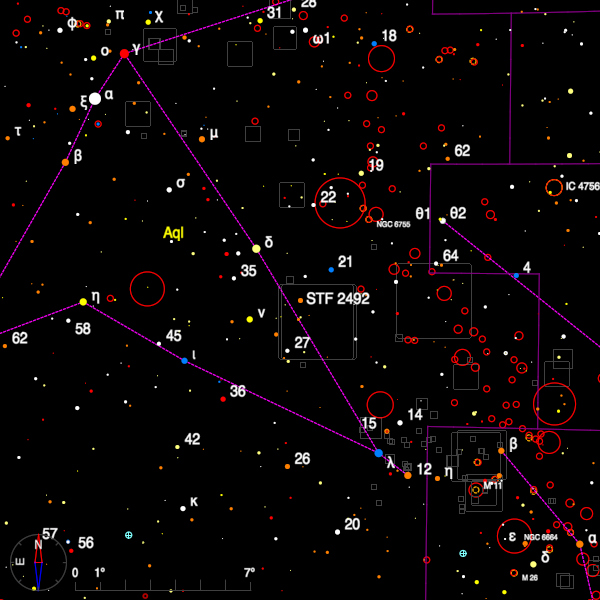August 2020 - Double Star of the Month

In preparing this column I checked my list of measures for 23 Aquilae = STF 2492 (19 18 32.50 +01 05 06.5) and found to my surprise that I had never observed it with the 8-inch refractor.
William Herschel first noted it in 1781 when he recorded Excessively unequal; the small star is just visible with 227..
. Since then the stars appear to be widening and Gaia DR2 astrometry puts them at 2 degs and 3".27 for 2015.5. The Gaia results show that they are not strictly at the same distance - the difference
between the parallaxes for each component is about ten times as large as the quoted
error in the distance of B, although the error on the bright star is large and may be expected to be improved upon when the Gaia Early DR3 catalogue is issued. This was supposed to happen in the next month or two, but it now seems likely it will be put back due to COVID-19.

Also in Aquila is STF 2597 (19 55 19.50 -06 44 05.22), another system which has not graced my eyepiece. One reason for this is that in the early 1970s it was only 0".04 apart and has been slowly widening since then.
The USNO 6th catalogue of orbits shows a highly elongated apparent orbit and the eccentricity of the true orbit is actually 0.94, one of the highest known. The stars are also quite unequal (6.9 and 8.0) which adds to the difficulty of visual resolution.
The great Italian observer Ercole Dembowski suspected an elongation of the brighter star in PA 140 degrees in 1864 but this has not been confirmed. More than 50 observations over the last 40 years with speckle cameras on large telescopes have not shown a third component.
The 425 year orbit for this system puts the components at 100 degrees and 0".75 for 2020.5. STF 2597 can be found just 1.5 degrees north of the pretty pair 57 Aquilae, more on which will appear in next month's column.
Bob Argyle - Double Star Section Director